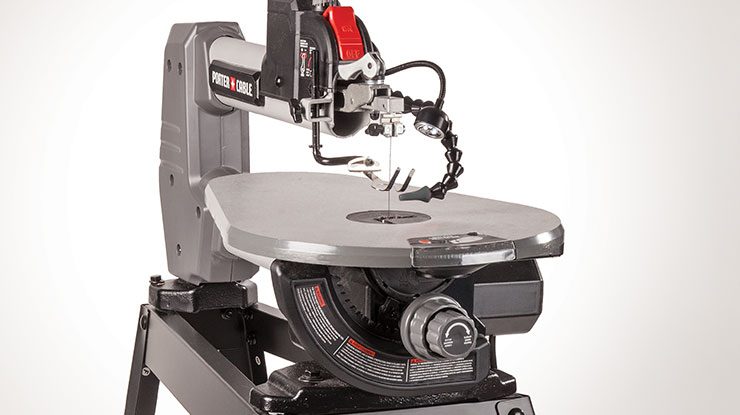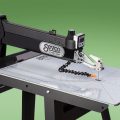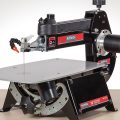We broke blades, burned wood, and said a few bad words. But we still think this scroll saw is the best on the market in the under $200 category
By Jon Deck, Bob Duncan, Mindy Kinsey, and Kaylee Schofield
Widely available, reasonably priced, and tricked out with a stand and accessories, Porter Cable’s model PCB375S is the best entry-level scroll saw on the market.
According to the popular scroll saw blogger Steve Good, “The Porter Cable scroll saw is a nice machine to get started in the hobby. It has all the features you need to be productive, even doing fine fretwork. It has up-front controls, toolless blade change, a light, and a dust blower. As an entry level machine it does come with some compromises. Blade changing is not as comfortable as with some saws, but it gets easier with practice. If the saw fits your budget, I can recommend this machine for a hobbyist.”
Saw Features
To test the saw, four staff members cut an assortment of projects ranging from thin fretwork to thick compound cuts. The first thing our beginning scroller noticed about this saw was its large and brightly colored power switch. Placed front and center, the switch gave that scroller confidence that, should something go wrong, she could turn the machine off quickly. She also found the centrally located speed control convenient.
Unlike many other saws, this one comes with both a stand and a light. The LED light is bright and easy to adjust so it shines exactly where you need it. On the other hand, the dust blower is disappointing. It doesn’t blow strong enough to clear the sawdust from the pattern lines and it often drifted out of position. Because they are next to each other, we bumped the light when we adjusted the blower. We actually broke the blower tip during testing. Other accessories include a blade drawer and a dust collection port. (We didn’t find either useful and ultimately removed them.)
The Porter Cable can use either pin-end or plain-end blades. Although pin-end blades are more widely available at local hardware stores, we suggest using the more versatile plain-end blades. We tested the saw using high-quality plain-end blades. They are held in place by a standard thumb screw system and tensioned with a lever on the saw arm. More on the tensioning in a minute.
To make angled cuts, the left side of the saw table tilts 45° using a rack and pinion system with a knob. The angle gauge is in the tabletop. We found the system to be accurate to within 3° when tested with a digital gauge. An adjustable stop makes it easy to return the table to square. If you move the stop aside, you can tilt the right side of the saw down 15°.
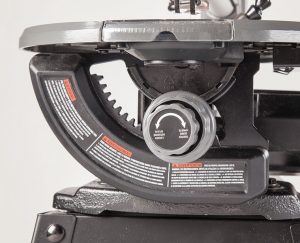 |
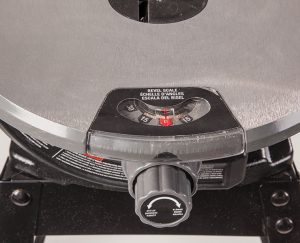 |
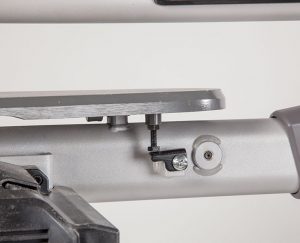 |
| The rack and pinion adjustment knob works smoothly and locks securely. | The topside angle readout is a handy feature, although not entirely accurate. | The adjustable stop returns the saw table to 0° with fairly good accuracy. |
In Action
In our first set of tests, we had testers who loved this saw and testers who hated it. It’s unusual to have such a range of reactions, so we gathered ’round the saw to figure it out. Turns out, there were a couple of easily solved problems that we needed to address.
First, the blades slipped out of the holders. Then, even after we fixed the blade holder, we had trouble changing blades because there so much stuff under the table—a blade drawer, dust collection port, and a solid plastic panel—that even testers with small hands couldn’t reach the blade holder. The blade holders were also oddly loose so they wiggled awkwardly during blade changes.
As we used the saw over the course of two weeks, we gradually lost the ability to tension the blade or even fold down the tensioning lever. Not only did that make scrolling impossible because the loose blade flopped around, but it chewed up the plastic blade insert so that projects caught on the rough edges. We found the removable insert handy for seeing inside the saw during blade changes, but it was recessed just enough to snag the wood while we scrolled.
So, given that list of issues, why do we recommend this saw? Because once we identified and solved our problems (see our Troubleshooting list), it works really well. It cuts smoothly and accurately, even on thick wood. It has very little vibration, making it comfortable to use for long sessions of scrolling—something that is rare among less expensive saws.
With its 18″ throat, 12 1/2″-wide table, and 3″ head clearance (about 2″ of sawing space), the saw is big enough to accommodate almost any size of project and allow you to experiment with many types of scrolling as you explore the hobby. The tilting table works smoothly, and we appreciated the adjustable stop that makes it easy to return the table to horizontal. The head is fixed, which makes feeding blades for fretwork projects a little awkward, but once we got the hang of blade changes they were quick and easy. We taught a complete novice how to scroll using this saw, and she both enjoyed the process and was eager for more projects.
Porter Cable’s model PCB375S will let anyone get started scrolling and try a wide variety of projects without breaking the bank. You may have to fiddle with it a little, but on the whole it works well, has all the features you need to explore the hobby, and is a good value. We recommend it as the best entry-level saw on the market.
The Porter Cable PCB375S is available at Lowe’s stores for $199. To find a store, visit www.lowes.com or call 1-877-GO-LOWES.
Troubleshooting
• Blade slipping: We took apart the holder and discovered that the end of the top blade screw was cupped, so only a few thin pieces of metal were making contact with the blade. To fix it, place fine-grit sandpaper on a flat surface. Remove the thumbscrew from the blade holder and hold it upright as you rub it back and forth on the sandpaper to remove any oil from the screw and flatten the surface.
• Clamping blades tightly: To better tighten the thumbscrews on his DeWalt machine, reader George A. Ulrick, Jr., of Beatrice, Neb., traced the thumbscrew onto a piece of oak and cut the shape to create a custom wrench. We did the same thing for the Porter Cable and found it helped us fasten the thumbscrews tightly.
• Access to bottom blade holder: Remove the panel from the left side, and remove the blade drawer and dust collection outlet from the right side.
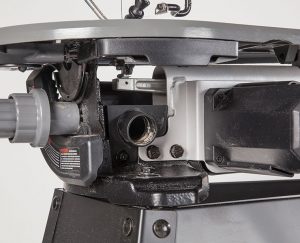
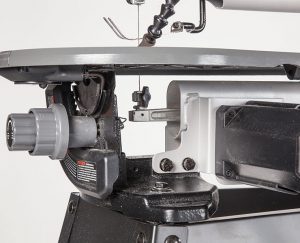
Before After
• Loose blade holders: Fixing the tensioner helps. If you’re still having trouble, replace the roll pin with a machine screw and nut. Use washers around the holder to stabilize it.
• Tensioner malfunction: After fiddling with the mechanism, we realized that each time you change and re-tension the blade, you use up a little of the tensioning space between the blade holder assembly and the saw arm; when the space is gone, the tension lever no longer works. To reset it, unscrew the tensioner the whole way. Install ablade with the ends flush with the bottom of the lower blade clamp and the top of the upper blade clamp, and tension the blade. You will need to do this periodically as you scroll.
• Blade insert: If your insert sits too low, add a shim to the bottom so it’s level with the table or trace it onto a piece of wood and cut a new, thicker one. If the blade chews up the insert, either buy or cut a new one.
• Dust blower strength: If the blower doesn’t clear the dust and it bothers you to blow the dust away yourself, supplement it with an inexpensive aquarium pump. You can position the aquarium hose as needed or slip it into the existing blower tube. Many scroll saw supply stores carry flexible extension tubes for dust blowers.
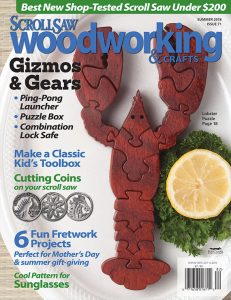 • For more great reviews and projects, check out Scroll Saw Woodworking & Crafts magazine.
• For more great reviews and projects, check out Scroll Saw Woodworking & Crafts magazine.
• For our video on hacking a Porter Cable scroll saw, click HERE.
• Pick up the latest issue HERE.


